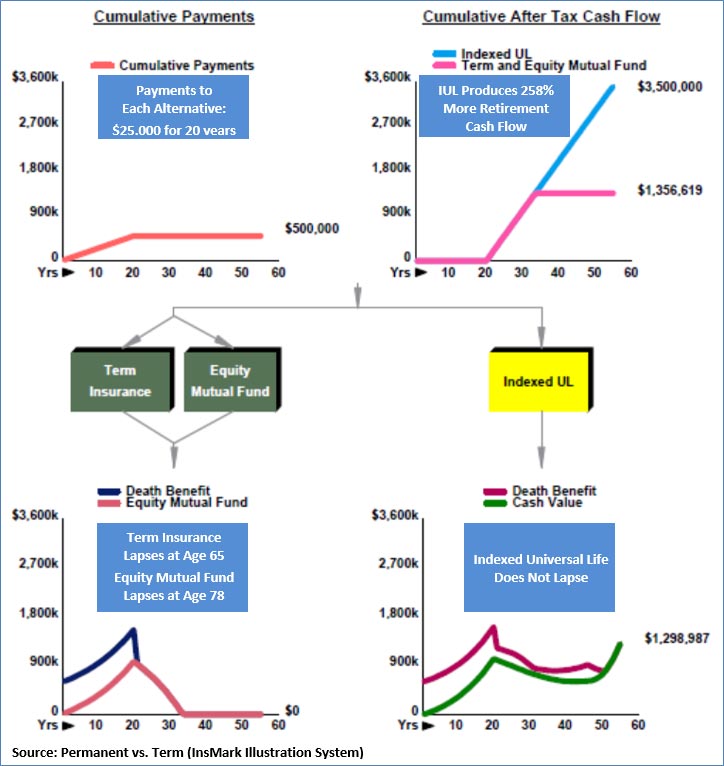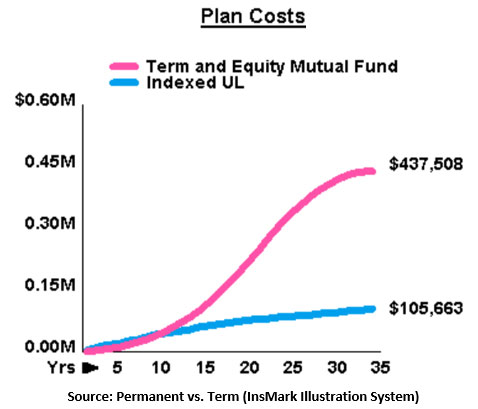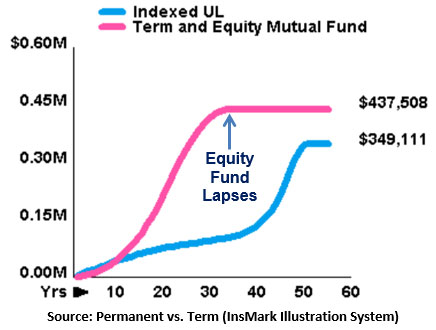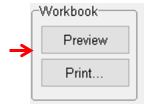(Click here for Blog Archive)
(Click here for Blog Index)
(Presentations in this blog were created using the InsMark® Illustration System)



In Blog #199, we introduced you to InsMark’s Prudent Care™ featuring a comparison of three different variations of the same Indexed Universal Life (IUL) illustrated at 6.90%, 6.00%, and 5.00%. Each policy illustration has 20 premiums of $25,000. We used InsMark’s new InsMark Compare illustration (located in the InsMark Illustration System) for the analysis. Click here to review that illustration.
We also compared the IUL to the following accounts using our Various Financial Alternatives illustration module: taxable at 6.90%, tax-deferred at 6.90%, and equity fund at 6.90% plus a 2.00% dividend, each one turning out to be a disappointing alternative to the IUL. Click here to review that illustration.
Our popular Permanent vs. Term comparison module is featured in Blog #200. Again, IUL’s superior performance outguns a combination of 20-year, level term with a $600 premium and an equity mutual fund at 6.90% (with a .50% mgt. fee plus a 2.00% dividend).
Permanent vs. Term
Please review the graphic below, assuming that Jack Hudson, age 45, and his wife, Amy, are your potential clients.
| Image 1 |
| Indexed Universal Life vs. |
| 20-Year Level Term insurance and an Equity Fund |

Click here to review the Permanent vs. Term illustration.
This InsMark illustration shows a devastating advantage for permanent coverage. Unfortunately, the illustrated equity mutual fund produces a classic case of running out of money in retirement as it expires at Jack’s age 78. The illustrated IUL does not expire.
Suze Orman, Dave Ramsey, and Jim Dahle, MD (the White Coat Investor®)
Don’t let your clients get trapped believing the “buy term and invest the difference” misrepresentations from Suze Orman, Dave Ramsey, and Jim Dahle, MD (the White Coat Investor®). Their advice is words and opinions only. Provided your clients have the available cash flow to consider permanent life insurance, let year-by-year comparative mathematics guide their decisions (something Suze, Dave, and Jim never include in their false narratives about permanent life insurance).
In order to match the Indexed Universal Life, the equity fund must have growth of 10.41% plus the 2.00% dividend (551 basis points more than the IUL).
Some clients will express disbelief that IUL can reasonably have such an advantage. Here are the core reasons why IUL performs better than “term and invest the difference”:
- Unlike the equity fund, all the values of the IUL grow tax-free and are distributed tax-free (via secured loans).
- Unlike the term insurance that lapses at age 65, the illustrated IUL does not lapse.
- Unlike the equity fund, IUL cash values do not decrease in down-markets; however, they increase with up-markets.
- Secured loans from the IUL are automatically repaid at death on a tax-free basis from the policy death benefit.
- Unlike the equity fund, tax-free cash flow from the IUL (via secured loans) experiences automatic enhancement due to the availability of participating loans. This unusual feature ensures that cash values securing such loans participate in the same stock index credited to non-loaned cash values. Read my Blog #52 for a discussion of participating loans.
- Plan Costs: Unlike the equity fund with hefty tax and internal expenses, the IUL’s mid- and long-range cumulative costs are substantially less, part of the reason it performs so well.
Comparison of Plan Costs
During the first nine years, cumulative Plan Costs are more for the IUL, and this is where both Suze Orman and Dave Ramsey typically center one of their core objections to cash value life insurance. As you can see in the graphic that follows, starting in year 10, and every year after, costs of the term and equity fund surge well past the IUL. This should eliminate Suze’s and Dave’s criticism.
Below are two graphics from the Permanent vs. Term illustration module comparing the Plan Costs of the term and equity fund to the recommended IUL.
The first graphic compares cumulative Plan Costs in the last year that the equity fund retains any value (Jack’s age 78; Year 34).
| Image 2 |
| Comparison of Plan Costs |
| (Jack’s age 78; Year 34) |

Below is the Plan Cost comparison extended to age 100. The IUL still retains values and produces cash flow. Its Plan Costs have continued to rise — a small price to pay as the term insurance and equity fund have each lapsed years earlier.
| Image 3 |
| Comparison of Plan Costs |
| (Jack’s age 100; Year 55) |

Both Comparison of Plan Costs graphics above compare the term insurance costs, management fees, and taxes of the equity mutual fund to the mortality charges and policy expenses associated with the life insurance policy. Plan Costs are impressively in favor of IUL, and this is one of the core reasons for its superior results.
Click here to review all the proposals in one illustration format organized as follows as a composite of Blogs #199 and #200:
- Pages 1 through 8: InsMark Compare™ illustrations.
- Pages 9 – 21: Various Financial Alternatives (main reports including Plan Costs).
- Pages 22 – 33: Permanent vs. Term (main reports including Plan Costs).
- Pages 34 – 50: Appendix #1 for Blog #199 (with several backup pages detailing calculations featured in Various Financial Alternatives).
- Pages 51 – 56: Appendix #2 for Blog #200 (with several backup pages detailing calculations featured in Permanent vs. Term).
Conclusion
During my years of producing substantial amounts of cash value life insurance (MDRT, TOT, Forum) and emphasized since the beginning days of InsMark in 1983, I have believed that clients make better decisions when comparing financial recommendations to other alternatives. It is better to do this with clients rather than their doing it by themselves — or worse, doing it with someone else who is not particularly open-minded about life insurance.
Blogs #199 and #200 bring you InsMark’s best analytics for helping your clients determine which is the best life insurance for, in this case, Jack and Amy Hudson. “Best policy for my client” cannot be established by a standard that applies to all clients. It must be determined instead by an objective analysis that is unique to each client as to the type of policy as well as each client’s personal comfort with different levels of the death benefit, cash value, cash flow, and interest or dividend assumptions.
The evaluation contained in Blogs #199 and #200 confirms that InsMark’s Prudent Care™ helps guide your client’s selection of the most suitable life insurance policy. This Blog is InsMark’s best effort to provide you with a presentation sequence that is impressive and convincing — and I hope it is useful to you.
Many of you have your specific suitability procedures, and I am not suggesting you abandon them. We are providing you with InsMark Prudent Care™ for you to include as a coordinated part of your suitability analysis — because it also acts as a superb interviewing resource unlike most of the suitability output with which you have to deal.
Illustration Suggestions
 You can create all-proposals-in-one-illustration by using this prompt on the Workbook Main Window of the InsMark Illustration System. If you download the InsMark Illustration System digital Workbook file for Blog #200 available below, there is a Notes section at the bottom of the Workbook Main Window with some text to help you prepare an all-proposals-in-one-illustration.
You can create all-proposals-in-one-illustration by using this prompt on the Workbook Main Window of the InsMark Illustration System. If you download the InsMark Illustration System digital Workbook file for Blog #200 available below, there is a Notes section at the bottom of the Workbook Main Window with some text to help you prepare an all-proposals-in-one-illustration.
Your Comments
What are your thoughts and conclusions after reviewing this material? Please add your comments to this Blog. Your email address will not be published.
Life Expectancy
Jack’s life expectancy at his current age of 45 is 83. His and Amy’s joint life expectancy is age 90, which means one of them, on average, should remain alive after 90.
Why did I illustrate this Case Study to age 100? Because there are more centenarians living today than ever before. There are estimated to be 80,000 U.S. centenarians in 2019, a figure expected to grow to about 3,676,000 in 2050, according to a recent report by Pew Research Center, the Washington D.C.-based think tank.
A critical aspect of IUL is that it can remain in force to age 120 for the rare person who lives anywhere near that long. If death occurs before that, the unique tax-free dollars of death benefit are present for beneficiaries — eliminating any deferred income tax inherent in the policy loan aspect of the transaction. The foundation of this particular treatment is IRC Section 101 that provides the proceeds of life insurance maturing as a death claim are exempt from federal income tax. This advantage applies to the full death benefit, including any cash value component, whether loans exist or not.
Licensing
To reproduce your versions of the illustrations and graphics in this Blog, license the InsMark Illustration System by contacting Julie Nayeri at julien@insmark.com or 888-InsMark (467-6275). You can also license it at online. Institutional inquiries should be directed to David Grant, Senior Vice President – Sales, at dag@insmark.com or (925) 543-0513.
InsMark’s Digital Workbook Files
If you would like some help creating customized versions of the presentations in this Blog for your clients, watch the video below on how to download and use InsMark’s Digital Workbook Files.
If you would like highly qualified, illustration design assistance with no commission split required, contact LifePro Financial, InsMark’s Referral Resource, discussed below.
Digital Workbook Files For This Blog
New Zip File Downloaders
Watch the video.
Digital Workbook Files For This Blog
Experienced Zip File Downloaders Download the zip file, open it, and double click the Workbook file name to open it in your InsMark System.
|
Note: If you are viewing this on a cell phone or tablet, the downloaded Workbook file won’t launch in your InsMark System. Please forward it to your PC where your InsMark System(s) are installed. |
For help on how to use InsMark software, go to The Quickest Way To Learn InsMark.
InsMark’s Referral Resources
(Put our Illustration Experts to Work for Your Practice)
We created Referral Resources to deliver a “do-it-for-me” illustration service in a way that makes sense for your practice. You can utilize your choice of insurance company, there is no commission split, and you don’t have to change any current relationships. They are very familiar with running InsMark software.
Please mention my name when you talk to a Referral Resource as they have promised to take special care of my readers. My only request is this: if a Referral Resource helps you get the sale, place at least that case through them; otherwise, you will be taking unfair advantage of their generous offer to InsMark licensees.
Save time and get results with any InsMark illustration. Contact:
- Ben Nevejans, President of LifePro Financial Services in San Diego, CA.
![]()

Testimonials
“InsMark has created without question the best suite of software for our industry that has ever existed. I personally have been using their software for almost 30 years, and it changed my career. This unique and user friendly software will add many thousands to your income for as long as you’re in business. InsMark makes me look good, and it will you as well.”
Simon Singer, CFP®, CAP®, RFC®, Past President International Forum, InsMark Platinum Power Producer®, Encino, CA
“The InsMark software is indispensable to my entire planning process because it enables me to show my clients that inaction has a price tag. I can’t afford to go without it!”
David McKnight, Author of The Power of Zero, InsMark Gold Power Producer®, Grafton, WI
“InsMark has increased my production by 10 fold. It clearly communicates to the client the best financial scenario to take.”
Gary Sipos, M.B.A., A.I.F.® InsMark Platinum Power Producer®, Sipos Insurance Services, Freehold, NJ
“InsMark is the Picasso of the financial services world — their marketing savvy never fails to amaze me.”
Doug Peete, Past President, Top of the Table, and InsMark Power Producer, Overland Park, KS

“InsMark”, “Wealthy and Wise” and the InsMark logo are registered trademarks of InsMark, Inc.
“InsMark Compare” and “InsMark Prudent Care” are trademarks of InsMark, Inc.
Copyright © 2020 InsMark, Inc.
All Rights Reserved

Important Note #1: The hypothetical life insurance illustrations and alternative investments referred to in this Blog assume the nonguaranteed values shown continue in all years. This is not likely, and actual results may be more or less favorable. Actual illustrations of life insurance are not valid unless accompanied by a basic illustration from the issuing life insurance company.
Important Note #2: The information in this Blog is for educational purposes only. In all cases, the approval of a client’s legal and tax advisers must be secured regarding the implementation or modification of any planning technique as well as the applicability and consequences of new cases, rulings, or legislation upon existing or impending plans.
Important Note #3: Many of you are rightly concerned about the potential tax bomb in life insurance that can accidentally be triggered by a careless policyowner when policy loans are present and net cash values are so low that the income tax on the gain on surrender (calculated using gross cash values less basis) is more – often significantly more – than the net cash surrender value.
This lurking tax bomb can be present in all forms of whole life and universal life where policy loans of any type are utilized. It can be avoided, and you, the producer, are key to making sure your clients are aware of how to sidestep it.
A tax bomb can be avoided if the policy is neither surrendered nor allowed to lapse, since the policy death benefit wipes away the income tax liability. The foundation of this special treatment is IRC Section 101. This statute provides that the proceeds of life insurance maturing as a death claim are exempt from federal income tax. This applies to the full death benefit, including any cash value component whether loans exist or not.
Can your clients remember these facts years into the future? If they are incapacitated, will family members understand the issues? It is probably best to file a short note with the policy – something like this (although your compliance officer will likely have preferred language):
If/when you take policy loans on this policy, be sure to talk to your financial adviser before surrendering or lapsing the policy in order to anticipate unexpected tax consequences that may otherwise be avoided.
Some life insurance companies have concierge units that monitor loan status at the point of lapse or surrender, and you would be well-advised to select an insurance company with this capacity. To be effective regarding the tax bomb, such carriers need to be proactive in their client relationships, not merely reactive to client inquiries. I hope that ultimately the policyholder service division of all life insurance companies will bring this potential liability to the attention of those surrendering or lapsing policies, particularly those policies with 50% or more of the gross cash value subject to outstanding loans.
![]()
More Recent Blogs:
Blog #199: InsMark’s Prudent Care™ Analysis (Part 1)
Blog #198 How Far Will $1,000,000 Go (Part 2) Joe and Annie Jordan’s Comprehensive Retirement Plan
Blog #197: How Far Does $1,000,000 Go (Part 1)
Blog #195: CheckMate® Logic (Part 3 of 4) Religion, Politics, Sex, and Term Insurance
| 3 Reasons Why It’s Profitable For You To Share These |
| Blog Posts With Your Business Associates and |
| Professional Study Groups (i.e. “LinkedIn”) |
Robert B. Ritter, Jr. Blog Archive




